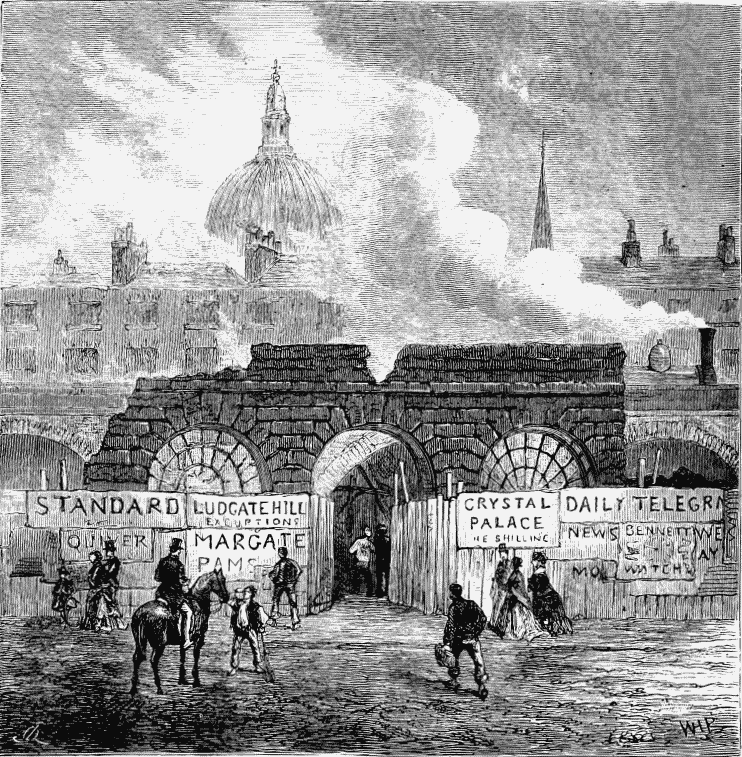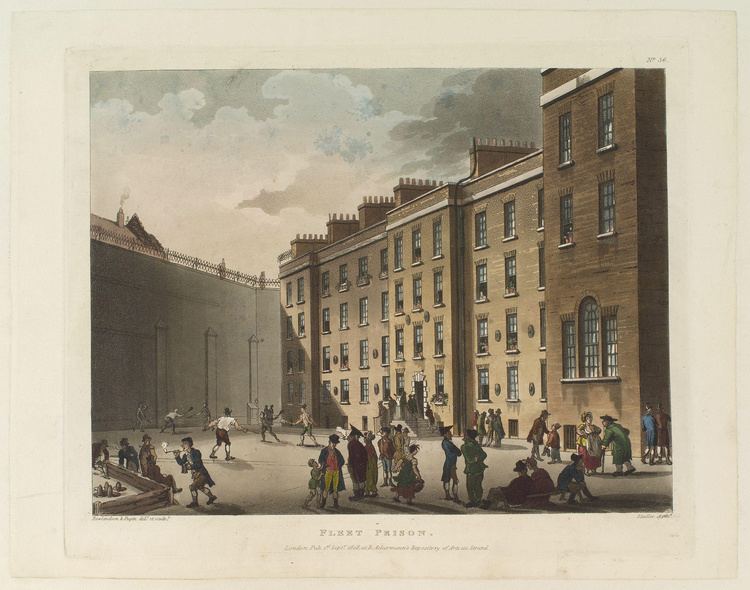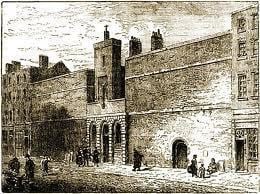Destruction date 1846 | Destroyed by Demolition | |
 | ||
Similar Marshalsea, Newgate Prison, Bridewell Palace, Gatehouse Prison, Millbank Prison | ||
The pickwick papers mr jingle in fleet prison
Fleet Prison was a notorious London prison by the side of the River Fleet. The prison was built in 1197, was rebuilt several times, and was in use until 1844. It was demolished in 1846.
Contents
- The pickwick papers mr jingle in fleet prison
- History
- Wardens of the Fleet prison
- Notable inmates
- Notable fictional inmates
- References

History

The prison was built in 1197 off what is now Farringdon Street, on the eastern bank of the River Fleet after which it was named. It came into particular prominence from being used as a place of reception for persons committed by the Star Chamber, and, afterwards, as a debtor's prison and for persons imprisoned for contempt of court by the Court of Chancery. In 1381, during the Peasants' Revolt, it was deliberately destroyed by Wat Tyler's men.

In 1666, during the Great Fire of London, it was burned down on the third day of the fire, the prisoners fleeing in the last moments. The then-warden of the prison, Sir Jeremy Whichcote, purchased Caron House in Lambeth after the fire to house the prison's debtors while the prison was rebuilt on the original site at his own expense.

During the 18th century, Fleet Prison was mainly used for debtors and bankrupts. It usually contained about 300 prisoners and their families. Like the Marshalsea prison, it was divided into a restrictive and arduous Common Side and a more open Master's Side, where rent had to be paid. At that time, prisons were profit-making enterprises. Prisoners had to pay for food and lodging. There were fees for turning keys or for taking irons off, and Fleet Prison had the highest fees in England. There was even a grille built into the Farringdon Street prison wall, so that prisoners might beg alms from passers-by. But prisoners did not necessarily have to live within Fleet Prison itself; as long as they paid the keeper to compensate him for loss of earnings, they could take lodgings within a particular area outside the prison walls called the "Liberty of the Fleet" or the "Rules of the Fleet". From 1613 on, there were also many clandestine Fleet Marriages. The boundary of the Liberties of the Fleet included the north side of Ludgate Hill, the Old Bailey to Fleet Lane and along it until the Fleet Market, and ran alongside the prison to Ludgate Hill.

The head of the prison was termed the warden, who was appointed by letters patent. It became a frequent practice of the holder of the patent to farm out the prison to the highest bidder. This custom made the prison long notorious for the cruelties inflicted on prisoners. One purchaser of the office, Thomas Bambridge, who became warden in 1728, was of particularly evil repute. He was guilty of the greatest extortions upon prisoners, and, according to a committee of the House of Commons appointed to inquire into the state of English gaols, arbitrarily and unlawfully loaded with irons, put into dungeons, and destroyed prisoners for debt, treating them in the most barbarous and cruel manner, in high violation and contempt of the laws. He was committed to Newgate Prison, and an act was passed to prevent his enjoying the office of warden.

During the Gordon Riots in 1780 Fleet Prison was again destroyed and rebuilt in 1781–1782. In 1842, in pursuance of an Act of Parliament, by which inmates of the Marshalsea, Fleet and Queen's Bench Prisons were relocated to the Queen's Prison (as the Queen's Bench Prison was renamed), it was finally closed, and in 1844 sold to the Corporation of the City of London, by whom it was pulled down in 1846. The demolition yielded three million bricks, 50 tons of lead and 40,000 square feet (3,700 m2) of paving. After lying empty for 17 years the site was sold to the London, Chatham and Dover Railway and became the site of their new Ludgate station.
Wardens of the Fleet prison
Notable inmates
(See "Category:Prisoners in the Fleet" below)
In 1601, the poet John Donne was imprisoned along with the priest who married him and the man who witnessed the match until it was proven that his wedding to Anne Donne was legal and valid.
One notable inmate was Samuel Byrom, son of the writer and poet John Byrom. Samuel Byrom was imprisoned for debt in 1725, and in 1729 he sent a petition to his old school friend, The Duke of Dorset, in which he raged against the injustices of the system:
Holland, the most unpolite Country in the World, uses Debtors with Mildness, and Malefactors with Rigour; England, on the contrary, shews Mercy to Murtherers and Robbers, but of poor Debtors Impossibilities are demanded ... if the Debtor is able to make up his Affairs with the Creditor, how many Hundreds are afterwards kept in Prison for Chamber-Rent, and other unjust Demands of the Gaolers? ... What Barbarity can be greater, than for Gaolers (without any Provocation) to load Prisoners with Irons, and thrust them into Dungeons, and manacle them, and deny their Friends to visit them, and force them to pay excessive Prices for their Chamber-Rent, their Victuals and Drink; to open their Letters and seize the Charity that is sent them; and, in short, by oppressing them by all the Ways that the worst of Tyrants can invent? Such Cruelty reduces the Prisoners to Despair, insomuch, that many choose rather to shoot, hang or throw themselves out of the Window, than to be insulted, beaten and imposed upon by the Gaolers ... if every Gaoler was allowed a yearly Sallary ... and no Gaoler suffered, under the severest of Penalties, to take either Bribe, Fee, or Reward, no Demand for Chamber-Rent, nor any Fees for Entrance or going out of Prison; in such a Case the Gaols would not swarm as they now do ... In foreign Countries, where the Romish Religion prevails, what Crowds of People of both Sexes, from the highest Prince to the meanest Peasant, thrust themselves into Religious Houses ... it is an apparent Injury to the Country ... too obvious to be denied, that the many Prisons in England, where so many Thousands of both Sexes are detained, is a greater Loss and Injury to the King and Country ...
Other notable inmates include:
